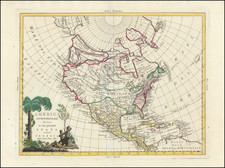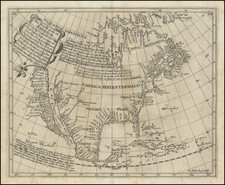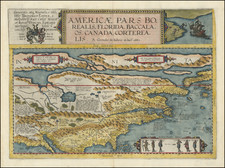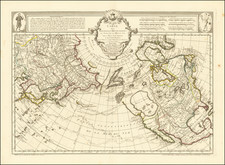Striking 18th Century map of North America, with decorative cartouche. The map includes a notation of a Chinese Colony Fou Sang, based upon Hui Shen's supposed voyage of 499 AD, in the area which would roughly be Puget Sound. This is one of the few maps which notes the supposed Chinese contact with the west coast of North America, which is reported upon in a number of generally discredited sources (most recently Menzies' 1421). The map shows several unusual projections of the Nothwest Passage, based upon reports from the Russian explorations recently published in the Royal Academy of Sciences in Paris, although not consistent with the reports of J.N. De L'Isle. North America is projected far too widce, with a number of long rivers extending from the Oregon and Washington Coasts to nearly the Mississippi, with the Bella Riviera reaching what would appear to be the Missouri and thereby creating a watercourse from the Mississippi to C. Bianco di San Sebastian (Cabo Blanco). Quivera, Anian, Nuova Albiona and a number of other early place names still appear, although many are moved inland from their traditional locations. Teguayo and the Pays de Moozemlek are also shown. Salt Lake (Lago Salado) appears in the central continent, due to the misprojection of the western coast. Lots of Indian Tribes noted. Gorgeous example. Issued as part of Zatta's Atlante Novissimo, one of the last great decorative atlases.
Antonio Zatta (fl. 1757-1797) was a prominent Italian editor, cartographer, and publisher. Little is known about his life beyond his many surviving published works. It is possible that he was born as early as 1722 and lived as late as 1804. He lived in Venice and his work flourished between 1757 and 1797. He is best known for his atlas, Atlante Novissimo (1779-1785), and for his prolific output of prints and books that were both precisely made and aesthetically pleasing. Zatta clearly had a large network from which to draw information; this is how he was able to publish the first glimpse of the islands visited by Captain Cook in the Atlante Novissimo. Zatta also published books of plays and architecture.










![[ Anchorage in the Future ] Anchorage and the Cook Inlet Basin - Captain Cook Returns 2035 A.D.](https://storage.googleapis.com/raremaps/img/small/78278.jpg)
![[ Alaska & Yukon ] Karte zur Abhanđlung über die Geogn. U. Orogr. Beschaffenheit der N.W-Küste Amerikas u. der anliegenden Inseln mit Zugrundelegung der Karten des Hydrogr. Dep. des See-Ministeriums zu St. Petersburg von C. Grewingk 1849](https://storage.googleapis.com/raremaps/img/small/101812.jpg)


![[French America and the Triangular Trade] L'Amérique Françoise Où son Décrites La France Nouvelle, La France Insulaire, La France Equinoctiale, et autre pais Par P. Du Val d'Abbeville Geographe du Roy . . .](https://storage.googleapis.com/raremaps/img/small/91968.jpg)
